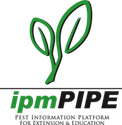I. Introduction and Extension Documents
Ia. Purpose of SWD ipmPIPE Phenology and Mapping Website 
Ib. SWD ipmPIPE Objectives 
Ic. SWD Introduction 
a) Overview (small poster) | 
|
b) Non-crop Hosts | 
|
Id. SWD Backyard Needs and Management 
a) Protecting Garden Fruits | 
|
b) Backyard Summary | 
|
c) Backyard Management | 
|
d) Backyard Sanitation | 
|
Ie. SWD Identification 
a) ID KEY | 
|
b) ID Scope Quick Guide | 
|
c) FLYer #2: Identification Information | 
|
If. SWD Monitoring 
a) SWD Monitoring Guide | 
|
b) Quick 7-Step Guide to Sampling | 
|
c) Servicing and Counting SWD Traps | 
|
d) Subsampling (Methods for very | 
|
e) Detailed Larval Sampling | 
|
f) 1-page Guide to Traps and Baits | 
|
g) FLYer #1: Monitoring Information | 
|
h) FLYer #3: Larval Sampling | 
|
Ig. SWD Management 
a) SWD Landscape Hotspots | 
|
b) Risky Situations | 
|
c) Using Degree-Days (1 page) | 
|
d) FLYer #4: Using the Degree-Day | 
|
e) Cold Storage Methods | 
|
f) FLYer #6: Overwintering Behaviors | 
|
II. SWD Incidence Reporting:
IIa. SWD Survey Status - CERIS  open in new window
open in new window
IIb. Relative Abundance Maps - Introduction

IIc. SWD Synoptic Reporting of Trap Data
 open in new window
open in new window
III. Current SWD Development (Phenology)
SWD Development/DD Model Webinar 
IIIa. Development Maps (updated daily):
 open in new window
open in new window
IIIb. Development Forecasts by Location - Western US:
|
| ||||||||||||||
IIIc. Development Forecasts by Location - Central US:
| |||||||||||||||
IIId. Development Forecasts by Location - Eastern US:
|
IIIe. Phenology by Month including Historical Estimates:
 open in new window
open in new window
National Maps (pdf): 2012 2011 2010 30-yr Normals Northwest Maps (pdf): 2012 2011
IV. SWD Overwintering Mortality Forecasts: SWD Overwinter Mortality Model Webinar
 open in new window
open in new window
Overwintering Mortality Model development and 30-yr Normals, Series above (pdf)





